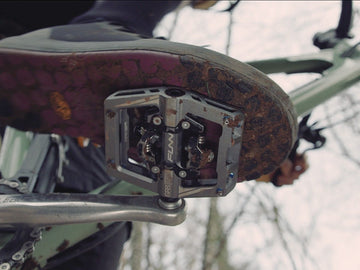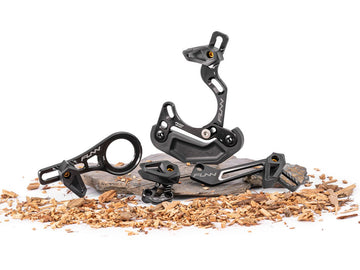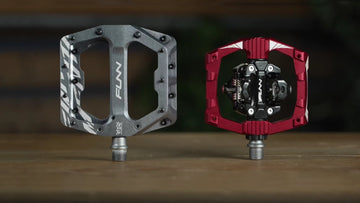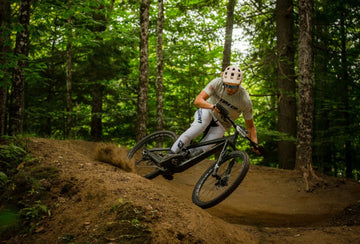
Welcome to our detailed guide on types of bike pedals. Here, we’ll explore the diverse range of bike pedal types and provide crucial insights to help you choose the right set for your cycling adventures. Discover how to select bike pedals that match perfectly with your riding style and needs.
Types of Bike Pedals
Exploring the various types of bike pedals is crucial for cyclists of all levels. In this section, we delve into the features and benefits of each pedal type, including Funn’s innovative product range, to help you make an informed decision that suits your cycling needs.
Flat (Platform) Pedals:
Widely used across various types of bicycles, flat pedals feature a simple, user-friendly design. They’re typically made from metal or plastic and feature a wide, flat surface without any clips, making them an excellent choice for both beginner and casual riders. Their straightforward design allows for quick and easy foot placement and removal, which is especially useful for urban riding and situations where quick stops are common. The textured surface of these pedals provides plenty of grip for different shoe types, making them suitable for daily commutes or leisurely rides.
In Funn’s product range, we offer the Python, Funndamental, Taipan and Black Magic pedals, each carefully engineered to meet the varied demands of cyclists with a focus on reliability and style.

Clipless Pedals:
Clipless pedals are an advanced system that securely attaches cycling shoes to the pedals using a two-bolt cleat system, commonly used in mountain biking. This connection improves pedaling efficiency as it allows cyclists to push down and pull up while pedaling. A critical aspect to remember is the need for shoes that are specifically compatible with the clipless system chosen.
There’s a learning curve to using clipless pedals; mastering the technique of clicking in and out is essential for safety and confidence on the trails. It typically requires practice to become proficient, especially for emergency disengagements. Riders new to clipless systems should take time to learn this skill in a safe environment before hitting challenging terrains. For more information, don’t forget to take a look at our comprehensive guide:“What Is Clipless Pedals? | Beginner’s Guide”
Within Funn’s selection, the Mamba, Mamba S, and Ripper pedals stand out as top-tier choices for those seeking clipless options.

One-Sided Clipless Pedals:
Funn’s innovative pedal designs, such as the Mamba and Mamba S, offer cyclists a one-sided clipless option, expertly blending the best of both worlds. These bike pedals feature a dual-functionality design — one side hosts a traditional flat pedal surface, while the other is equipped for clipless engagement. They are particularly beneficial for riders looking to transition to clipless pedals, providing the flexibility to ride either clipped in for efficiency or unclipped for quick dismounts.
It’s important to note that compatible shoes are required to utilize the clipless feature of the Mamba and Mamba S pedals, ensuring optimal performance and safety.

Types of Bike Pedal Materials
The material affects a pedal’s weight, durability, and overall performance. Different materials can impact factors like pedal strength, resistance, and cost. Here are the features of common bike pedal materials:
Aluminum:
Aluminum pedals are favored for their durability and are widely considered the standard in cycling due to their optimal balance of lightweight and strength. They provide the rigidity needed for efficient power transfer, making them sturdy enough for a variety of riding conditions without weighing down the bike.
In Funn’s pedal selection, you’ll find several excellent options that feature aluminum construction, including the Mamba, Mamba S, Ripper, Funndamental, and Python pedals. They provide riders with the advantages of aluminum pedals, making them ideal choices for those looking for reliable and efficient bike pedals.

Plastic:
Plastic pedals are a common choice for BMX enthusiasts and those just starting out in mountain biking. One of the advantages of these pedals is their cost-effectiveness; they’re typically much more affordable than their metal or carbon fiber counterparts. This makes them an excellent option for beginners who may not want to make a large investment while they’re still learning the ropes.
Additionally, plastic pedals have the added benefit of being less likely to cause serious injury in the event of a crash. Their material can offer a bit more give upon impact, which can mean a softer blow to the rider or anyone else involved in a tumble. This combination of lower cost and a safer profile during accidents makes plastic pedals a wise choice for new riders. Funn’s Black Magic and Taipan pedals are made of reinforced plastic, representing an excellent choice for riders eager to explore the advantages of plastic pedal designs.

Carbon Fiber:
Carbon fiber-reinforced pedals, predominantly seen in the road biking arena, are a result of advanced manufacturing techniques that inject plastic with carbon fiber. This combination yields a pedal that is lighter than most, aiming to enhance performance where speed and agility are paramount. The inclusion of carbon fiber typically means a higher price point, but for many road cyclists, the weight savings and the increased stiffness—which translates to efficient power transfer—are worth the investment.

Image source: Shimano.com
How Do I Choose the Right Pedal? 4 Factors to Consider
Riding style:
Flat pedals offer a combination of stability and convenience, allowing riders to ride with regular shoes. These pedals are an excellent choice for commuting and leisurely rides, providing a secure platform for your feet. Clipless pedals are ideal for mountain biking and road cycling, and excel in power transfer efficiency. Enabling quick engagement and disengagement, which is beneficial when navigating rough terrains.
Comfort:
Flat pedals offer comfort and ease of use, making them a popular choice for relaxed cycling experience. Provide a supportive platform for your feet. Cyclists favor clipless pedals for their ability to reduce foot fatigue due to their secure connections. One-sided clipless pedals offer both comfort and stability, making them an ideal choice for riders who value convenience and support.

Convenience:
Clipless pedals may require the use of cycling shoes, whereas flat pedals offer the advantage of being compatible with regular footwear. On the other hand, one-sided clipless pedals allow a seamless transition between both pedal systems. This versatility is ideal for riders who want to switch between clipless and flat pedals depending on their needs.
Installation and Maintenance:
It’s essential to understand the installation and maintenance procedures for your pedals. Various pedals may demand particular tools or techniques when installing and maintaining them. By familiarizing yourself with these aspects, you’ll ensure a trouble-free cycling experience. This knowledge will keep your pedals in optimal condition and prevent any unexpected issues during your rides.
For additional details, we recommend reviewing our comprehensive guide:”EASY WAY TO INSTALL AND REMOVE BIKE PEDALS | DIY GUIDE.”

Conclusion
Selecting the right pedals is a critical element of tailoring your mountain biking experience to your personal preferences and goals. Understanding the various types of bike pedals is the first step in identifying the ones that best suit your riding needs. The correct bike pedal choice can significantly enhance your control and efficiency on the trails, leading to improved performance and a more enjoyable riding experience. Whether you’re navigating challenging terrain, enjoying scenic cross-country routes, or taking on aggressive downhill courses, the perfect pedals are out there to complement your style and support your biking adventures.





